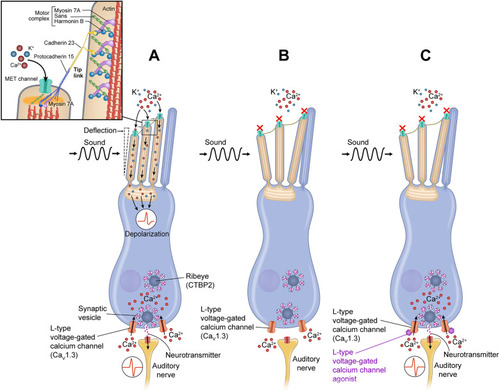
L-type voltage-gated calcium channel agonists restore function in hair cells. (A) In a normal hair cell, sound causes stereocilia to deflect towards the tallest stereocilium and induces the mechanotransduction channels (METs) at the top of the stereocilia to open in response, allowing cations such as calcium (Ca2+ ) and potassium (K+) to flow into the cell. This causes a change in membrane potential, which leads to the opening of L-type voltage-gated calcium channels at the basolateral sides of the cell. Calcium enters the cell and increases intracellular calcium concentrations, thereby mediating neurotransmitter release from synaptic vesicles within the ribbon synapse into the synaptic cleft, thus, stimulating afferent neurons. (B) In cells that lack MYO7A, correct MET channel gating does not occur. Therefore, the appropriate membrane potential is not reached to allow L-type voltage-gated calcium channels to open, and there is insufficient synaptic transmission to the auditory nerve to create meaningful interactions. (C) We hypothesize that, by augmenting the downstream signal in myo7aa−/− mutant hair cells, a new functional response to sound can be reconstituted when the sensitivity of the calcium channel is increased through treatment with L-type voltage-gated calcium channel agonists.
|

